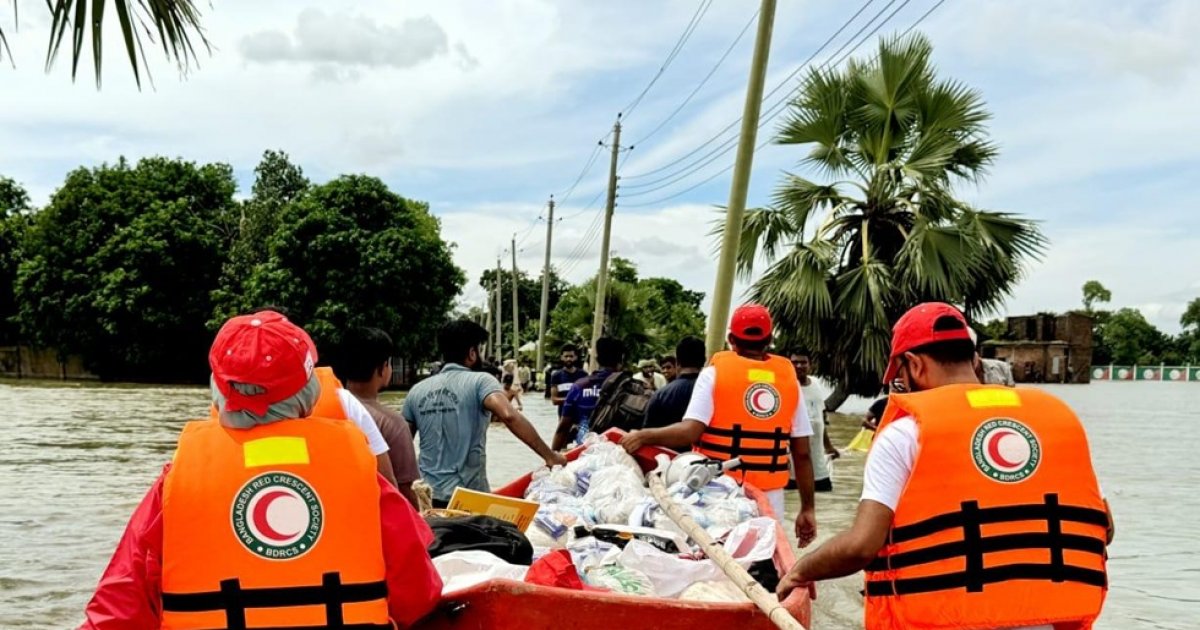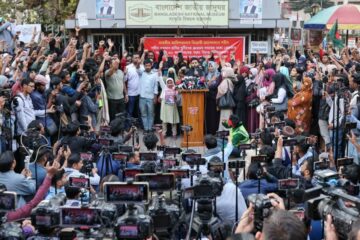In February this year, the newly sworn-in President Donald Trump abruptly ended the US Agency for International Development (USAID), causing a devastating impact on the global aid structure. With one decisive executive action, the entire operational framework of USAID, and Consequently, US international aid was dismantled: All upcoming initiatives were halted, and ongoing humanitarian and development projects were suddenly stopped.
The United States was traditionally the biggest donor in international aid. From 2001 to 2024, USAID had an average budget of $23 billion a year and missions in over 100 countries in areas as diverse as education, global health, environmental protection, and democratic governance.
In 20 years, from 2001 to 2021, USAID saved a yearly estimated range of between 4.1 and 4.7 million lives, with a yearly estimated subset of between 1.2 and 1.7 million children under five saved.
The consequences of this new foreign aid policy change have been both immediate and significant. Non-governmental organizations (NGOs) worldwide are grappling with the abrupt and total loss of their funding sources, while vulnerable communities are left in a precarious situation, lacking essential support systems.
For many years, USAID has not only been a key international donor but also a crucial institutional centre and repository of expertise, where committed professionals worked diligently towards the goals of global stability and human development.
Its absence is profoundly felt, creating a vacuum that threatens to destabilize decades of progress and cooperation. President Trump’s decision has intensified the ongoing crisis in international aid. While legitimate criticisms of aid structures exist, it’s essential to recognize that global development assistance remains vital.
Aid fosters stability, improves health and education, and creates economic opportunities — not only benefiting recipient nations but contributing to a more stable international order. The unilateral suspension of USAID exemplifies a deeper issue: A widening gap between donor-country decision-making and the actual needs on the ground.
At the same time, the global aid system is facing increasing scrutiny. Despite noble intentions, aid efforts are often undermined by structural inefficiencies and misaligned priorities.
A persistent disconnect between international donors and local NGOs can lead to wasted resources and diminished impact. If international aid is to remain effective and credible, it must evolve — becoming more transparent, inclusive, and responsive to those it intends to serve.
The plight of local NGOs
While positioned at the very forefront of development and humanitarian work, local NGOs are frequently encumbered by profound structural disadvantages that compromise their efficacy and sustainability.
A key issue is the asymmetry of power, which relegates these organizations to a subordinate role.
Rather than having the autonomy to design projects that are genuinely responsive to the true needs of their communities, they are often reduced to mere implementers. This top-down, donor-driven paradigm means they are simply executing strategies conceived in distant capitals, a dynamic that can lead to interventions that are misaligned with local realities and result in suboptimal outcomes.
Moreover, many local NGOs grapple with significant capacity constraints that are both a cause and the effect of this system. Lacking the resources and technical expertise to manage the complexities of large-scale, internationally-funded projects, these organizations often struggle to meet the stringent administrative and reporting requirements imposed by donors.
This issue is critically exacerbated by short-term, unpredictable funding cycles, which make long-term strategic planning virtually impossible. The imperative to constantly secure the next grant forces local NGOs into a state of perpetual fundraising.
This pressure can push organizations to alter their core mission to align with ever-shifting donor priorities, be it a sudden focus on climate change or a new emphasis on gender equality — even if these do not reflect the most pressing needs identified by their communities.
This mission drift ultimately compromises their original purpose and their vital link to the people they serve. Beyond these challenges, the reliance on external funding can create a cycle of donor dependency, which hinders the development of independent, resilient local civil societies.
When funding is tied to specific, measurable outputs that look good in a report but don’t address systemic issues, it can discourage innovative, locally — grown solutions that may take years to bear fruit.
The result is a system that, in some cases, unintentionally prioritizes the needs of the donors — in terms of demonstrating quick, visible results — over the long-term, sustainable development of the recipient communities themselves.
The donor’s dilemma
International aid is often funded by the hard — earned tax money of citizens in donor countries, making its effectiveness a matter of public accountability. Yet, in many developing contexts,NGOs are seen constructing small bridges, public toilets, and schools — services traditionally provided by governments.
This raises a critical question: What is the proper role of NGOs, and what should donors be funding?
Historically, NGOs were meant to complement — not replace — state functions. Their role was to address issues that are too politically sensitive, specialized, or marginalized for governments to handle, such as advocating for LGBTQ rights or supporting victims of domestic violence. NGOs were designed to fill gaps, not substitute for the state.
In fragile or under-resourced states, the reality has shifted. NGOs now routinely perform essential public service functions. While this meets urgent needs, it risks creating cycles of dependency and enabling governments to abdicate their responsibilities.
What contributes to this blurred boundary?
1. Governmental failure: When a state lacks the capacity, resources, or political will to provide basic services, NGOs often step in out of moral necessity, even if that means performing “government work.”
2. Donor preferences: Donors favour projects with clear, quantifiable outputs. It’s far easier to report the number of schools built than to demonstrate subtle shifts in public policy or institutional reform.
3. Funding structures: To avoid corruption or inefficiency, many donors bypass governments entirely and fund NGOs directly. While well-intentioned, this can unintentionally empower NGOs to take on roles beyond their original mandate and lead to fraud by the NGO founders themselves.
Even with massive financial resources, international donors face structural challenges that limit the impact of aid. One key issue is the epistemological gap — a lack of deep, local understanding. Without sufficient insight into the cultural, political, and social context, donors risk funding projects that are ineffective or culturally inappropriate.
This gap is often widened by geopolitical interests, where donor priorities are shaped less by recipient needs and more by strategic concerns — like securing trade partnerships or countering rival states. As a result, aid allocations can be skewed, sidelining humanitarian needs in favour of foreign policy goals.
The bureaucratic complexity of the aid system adds further strain. Extensive paperwork, rigid compliance requirements, and multi-layered approval processes slow aid delivery and drain organizational resources, forcing NGOs to prioritize administrative survival over mission-driven work.
Finally, measuring long-term impact remains a persistent challenge. Donors rely heavily on quantifiable outputs (eg: The number of wells drilled or teachers trained) rather than harder-to-measure outcomes (eg: Improved health or literacy rates). This institutional bias toward short-term, trackable metrics undermines accountability and can perpetuate shallow interventions that fail to address systemic, root-level issues.
In the end, the donor’s dilemma is not just about how much money is given — but how it is spent, who decides its use, and what vision of development it supports. Without deeper engagement, contextual understanding, and strategic reform, aid risks becoming a well-intentioned exercise in crisis management. Instead, aid should be a tool for meaningful, lasting change.
When money goes to waste
Aid money is intended for countries and communities in crisis, where lives are on the line. The misuse and waste of this aid are not just an economic failure, but a moral one. Systemic inefficiencies lead to significant resource wastage, ensuring that much of the money never reaches the people it is meant to help.
A substantial portion of aid funds is consumed by administrative costs overhead, including salaries for consultants and logistical costs. The duplication of efforts and a lack of teamwork among organizations is another widespread issue, as poor coordination among donors and NGOs often results in multiple organizations running nearly identical projects in the same areas, which wastes resources and creates confusion for local populations.
A well-known example of this is the post-2010 Haiti earthquake response. Following the devastating quake, billions of dollars in international aid poured into the country. However, much of that aid failed to reach the people who needed it most.
Large international NGOs and contractors implemented projects with little to no input from local communities. One infamous case was the American Red Cross’s project to build homes in Haiti: despite raising nearly $500m, the organization reportedly built only six permanent homes.
Investigations revealed that much of the money was spent on internal costs, subcontracting layers of organizations, and poorly managed programs. Meanwhile, many Haitians remained in temporary shelters years after the earthquake.
Another classic example of unintended harm is the donation of second-hand clothing from Western nations to Africa. While well-intentioned, this practice has flooded local markets and severely undermined the domestic textile industries, a critical source of livelihood. This is a clear case where a lack of local consultation led to a negative and lasting impact.
In Bangladesh, similar issues have been observed. For instance, in some post-flood disaster relief efforts, poorly coordinated international aid has led to the over-supply of certain goods and a neglect of others. In addition, there are too many cases of NGO founders misusing funds for personal gain.
These cases highlight the dangers of top-down aid delivery, poor oversight, and the exclusion of local voices. Without proper planning, coordination, and accountability, even the best-funded projects can fall short — or fail entirely.
Towards an effective aid system
To address these challenges, the international aid system must undergo a fundamental shift.
Localization of aid is key: By involving local NGOs in the design and decision-making process from the very start, projects can become more context-specific and aligned with the community’s true needs.
When local organizations have a say in how aid is allocated, it is far more likely to result in sustainable, impactful outcomes. Achieving this requires proactive, institutional collaboration: The embassies of donor countries, along with the relevant United Nations and World Bank bodies, must establish a clear, continuously updated overview of local NGOs on the ground and commit to ongoing strategic partnerships with them.
Another crucial step is investing in capacity building. Donors should focus on strengthening the capabilities of local NGOs and promote teamwork, providing them with the training, resources, and the technical expertise needed to manage large-scale projects. This shift would not only enhance the efficiency of aid delivery, but also ensure that these organizations can continue to have a lasting impact long after the donor funding has ended.
Adopting flexible, long-term funding models is an essential change. Short-term funding cycles can be detrimental to sustainable development, often forcing local organizations to focus on short-term results rather than long-term solutions.
By providing more stable, long-term financial support, donors can empower local NGOs to plan, adapt, and build more resilient programs. Lastly, improved coordination among all stakeholders — donors, NGOs, and local governments,
It is critical to maximize impact and avoid the duplication of efforts. A collaborative approach can prevent inefficiencies and ensure that aid is directed where it is needed most. Stronger transparency and accountability mechanisms, such as effective monitoring and evaluation systems must be implemented to track the effectiveness of aid and reduce the risk of corruption.
The experience of the Permaculture Institute Australia in Bangladesh underscores the limitations of conventional aid models. In their projects, rather than simply donating funds, they have focused on training local communities to develop self-sustaining permaculture systems with success. This bottom-up approach empowers communities to manage their own food, water, and energy resources, fostering long-term resilience and reducing dependency on external aid. This model stands in stark contrast to traditional aid, which often creates a cycle of dependency and is unsustainable once the funding runs out.
To create a more efficient and equitable aid system, we must focus on collaboration,transparency, and long-term investments in local capacity. We must reject the notion that aid is a one-way transaction. Instead, it must be seen as a long-term partnership in creating a better, more just world.
Julia Wesemann is Director, Growing Together.



